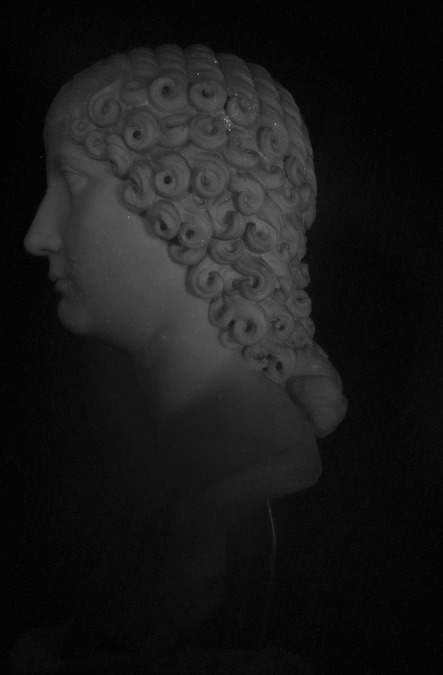Portrait of Staia Quinta
Summary
The portrait of a Roman woman reveals traces of original polychromy, especially in the hair where compact layers of yellow and red ochre with a few grains of Egyptian blue are observed. Small traces of red are also found on the skin even though it appears that the face has been vigorously cleaned.
Description of object
The portrait was inserted into a herm. The lowest part of the herm and the entire pedestal are modern.Whether the bust and the herm originally belonged together cannot be ascertained.
Archaeological Commentary
The insciption on the herm says: STAIA L L QVINTA, which means “L.L (Lucii Liberta – emancipated slave) Staia Quinta”.
Choice of methods
Visual examination
- Macroscopic
- Microscopic in situ
Technical imaging
- UV
- VIL
Sampling
- XRF
Visual examination
Red – yellowish layers dominate the colour of the hair especially on the left side of the portrait and on top of the head while a few traces of blue are found between the curls and in one case a single trace of a strong yellow is observed in the drill hole of a curl. Small traces of red are found on the left side of the neck as part of an original skin colour. Traces of red are also observed on the garments and on the button on the left side of the portrait
Technical imaging
UV-FL: UV-imaging does not show flourescent phenomena related to organic lakes or resins. However, a strong blue flourescence is observed on the right side of the neck and on the right cheek probably due to some modern treatment, although still unidentified.
VIL: Scattered particles of shiny bright white are seen in between the curls on the left side of the portrait. The characteristic glow of the particles confirms the use of Egyptian blue.
Other types of investigation
XRF: XRF analysis preformed in situ on the compact layer of red/orange found in the hair showes a high content of iron (Fe) suggesting the use of hematite or red ochre perhaps mixed with yellow ochre. The red colour observed on the button on the left side of the portrait also showes signal on Fe due to red ochre.
Bibliography
F. Johansen (1994), Roman Portraits I. Catalogue Ny Carlsberg Glyptotek, Copenhagen, 196-197, cat. no. 86.
- IN 1435
- Portrait herm
- 1st century CE
- Roman Imperial
- Marble
- Acquired in 1891 from Count Orsini, through the mediation of Helbig.
- H. 44 cm.; H. of herm: 1 m.

















